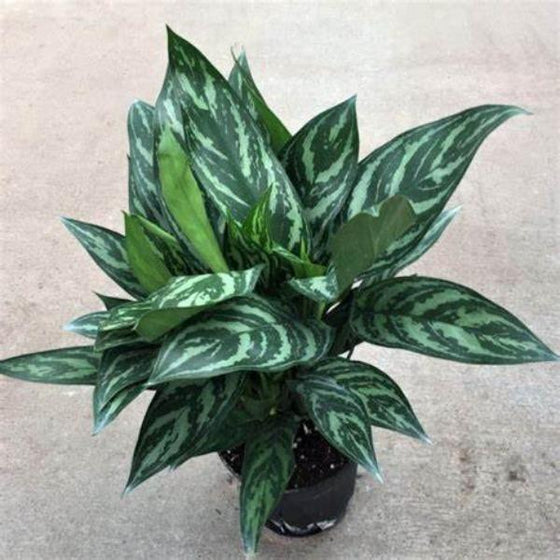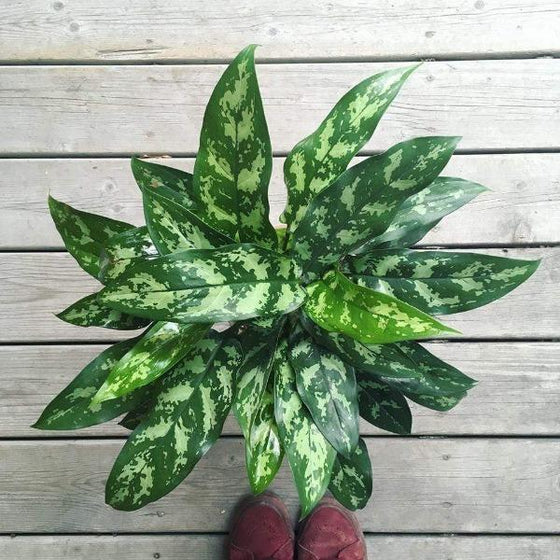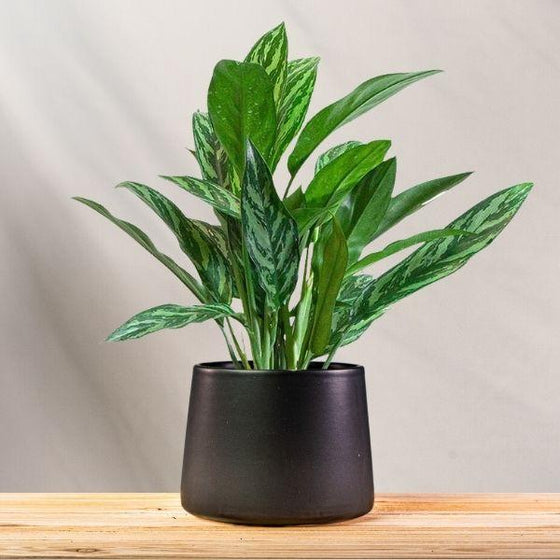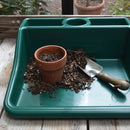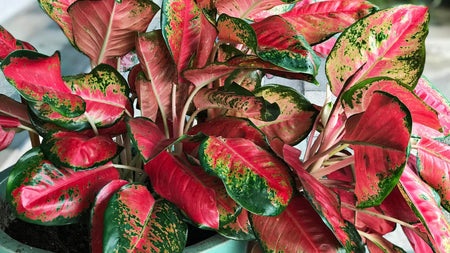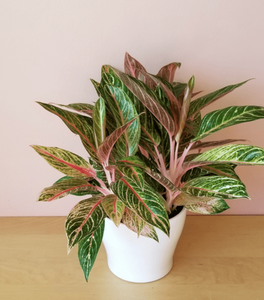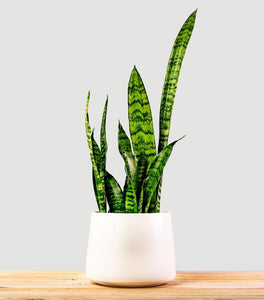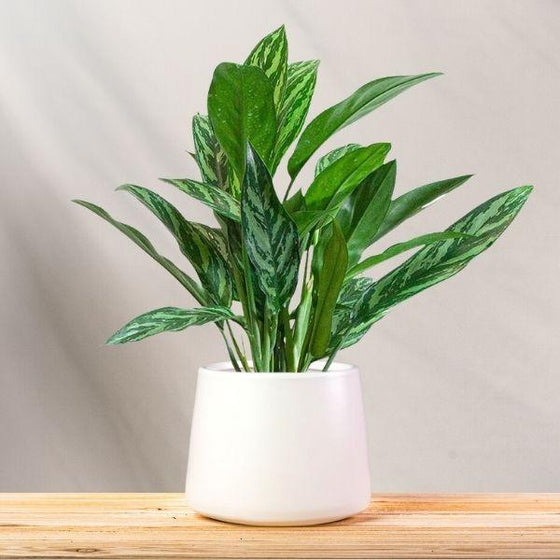
Images Depicted Range in Maturity & Container Size
Pots & Decorations Not Included Unless Otherwise Stated
Tigress Aglaonema: Tiger-Striped Foliage for Effortless Indoor Style
Jungle-Inspired Stripes in a Tough Houseplant
Tigress Aglaonema is a striking Chinese Evergreen cultivar known for its dramatic, tiger-striped foliage. Long, narrow leaves are patterned with bands of light and dark green, giving the plant a sleek, almost animal-print look that stands out in any room. The overall effect is modern and tropical at the same time, making Tigress a natural fit for contemporary interiors, cozy living rooms, and stylish workspaces alike. This is the kind of plant that instantly elevates a side table, shelf, or office corner without asking for fussy, high-maintenance care.
Upright, Elegant, and Space-Saving
Tigress grows as an upright, clumping houseplant with multiple stems emerging from the base to form a tall, graceful silhouette. Indoors, most plants mature to about 2–3 feet tall and roughly 1–2 feet wide, which is big enough to make a statement but compact enough to work on a plant stand, desk, or as a floor accent in smaller rooms. The leaves are more elongated than many other Aglaonemas, giving Tigress a refined, vertical presence that looks especially good against walls, in corners, or next to furniture. Its slow-to-moderate growth rate means it fills out steadily without overwhelming the space.
Indirect Light, Dry-Down Watering, and Cozy Temps
Like other Chinese Evergreens, Tigress is wonderfully forgiving. It prefers bright to medium indirect light but will adapt to lower-light conditions, making it ideal for offices and interior rooms. Direct, harsh sun can scorch the patterned leaves, so keep it a few feet back from bright windows or filter strong light with a sheer curtain. Plant Tigress in a well-draining indoor potting mix and water when the top 1–2 inches or roughly half the soil volume feels dry, letting excess water drain freely so the roots never sit in soggy soil. Average household humidity and temperatures between about 65–75°F are perfect; just keep it away from cold drafts and AC blasts.
Indoors as a Statement Foliage Accent
Tigress Aglaonema is best used indoors as a statement foliage plant. Its bold striping and upright form make it a natural focal point in living rooms, bedrooms, and entryways. Use it on its own in a clean, modern pot to highlight the leaf pattern, or group it with broader-leaved houseplants and trailing vines for a layered, jungle-inspired look. In offices and commercial spaces, Tigress is a go-to option for adding greenery to lobbies, conference rooms, and reception desks because it tolerates typical indoor light levels and routine care. As a long-lived foliage plant with a calm, sophisticated presence, Tigress is a fantastic way to bring “quiet luxury” greenery to any interior.

| Hardiness Zone: | Best as an indoor plant; outdoor only in frost-free zones |
|---|---|
| Mature Height: | Approx. 2–3 ft tall |
| Mature Width: | 1–2 ft wide |
| Classification: | Tropical evergreen houseplant (Chinese Evergreen) |
| Sunlight: | Bright to medium indirect light; tolerates low light, avoid direct sun |
| Soil: | Well-draining indoor potting mix; good aeration, never waterlogged |
| Flower Color: | Occasional small spathe/spadix blooms; grown mainly for striped foliage |
| Indoor Benefits: | Indoor air-purifying and décor plant; contributes to a fresher-feeling interior |
| Water Requirements: | Water when top 1–2 inches or ~50% of soil is dry; less in winter |
| Uses: | Desk plant, tabletop focal point, office plant, floor plant in smaller rooms |
How to Care for Aglaonema ‘Tigress’ (Tigress Chinese Evergreen)
Please follow our planting and care instructions for Aglaonema Tigress

How should I plant Tigress Aglaonema?
To plant Tigress Aglaonema, start with a container that has drainage holes and is only 1–2 inches wider than the current nursery pot. Chinese Evergreens prefer to be slightly snug rather than swimming in a large volume of soil. Add a layer of high-quality, well-draining indoor potting mix to the bottom of the new pot, then gently slide the plant out of its grower pot. Loosen any circling roots with your fingers and position the root ball so the top of the soil sits level with or just slightly above the rim of the new container. Backfill around the roots with potting mix, gently firming to eliminate air pockets without compacting the soil. After planting, give Tigress a slow, thorough watering until moisture runs from the drainage holes, then let the pot finish draining before placing it back on a saucer or into a decorative cachepot. Keep the crown of the plant at or just above the soil surface to help prevent rot. Although you can repot indoors at any time of year if the environment is warm and stable, spring and early summer are ideal because the plant is naturally entering a more active growth phase and will bounce back quickly.
How often should I water Tigress Aglaonema after planting?
Right after planting, water Tigress deeply to settle the soil around the roots. After that, let the top 1–2 inches of the potting mix—or about the top half of the pot in deeper containers—dry out before watering again. Use your finger or a moisture meter to check: if the upper soil feels dry, it’s time to water; if it still feels cool and damp, wait a few more days. This dry-down period lets the roots get fresh air and helps prevent the root rot that can happen if Aglaonemas stay constantly wet. In spring and summer, you might find yourself watering roughly once every 7–14 days depending on light, temperature, and pot size. In fall and winter, growth slows and the soil stays moist longer, so reduce the frequency and be especially careful not to water on autopilot. Always discard any excess water that collects in the saucer so the roots aren’t sitting in standing water, and remember that Tigress will forgive a missed watering more readily than repeated overwatering.
When should I fertilize Tigress Aglaonema?
Fertilize Tigress Aglaonema during the active growing season, typically from early spring through late summer. A balanced, water-soluble or slow-release houseplant fertilizer at half the recommended label strength every 4–6 weeks is plenty to support steady growth and keep the foliage lush and vibrant. Over-fertilizing can cause salt buildup in the soil and stressed roots, so it’s better to feed lightly and consistently than to push heavy doses. If you prefer a more organic approach, you can top-dress the soil with a thin layer of worm castings in spring or use an organic liquid fertilizer diluted to a gentle rate. Always combine feeding with good cultural practices—proper light, watering, and drainage—since fertilizer alone can’t fix issues caused by low light or chronically soggy soil. Hold fertilizer in winter when growth naturally slows and resume in spring as new leaves begin to emerge.

When and how should I prune Tigress Aglaonema?
Pruning Tigress Aglaonema is mostly about grooming and shaping. Use clean, sharp scissors or pruners to remove yellowing, brown, or damaged leaves at their base whenever they appear. If a stem has become leggy or top-heavy, you can cut it back just above a node (the small bump where a leaf emerges) to encourage branching and fuller growth. The best time for more noticeable shaping is in spring or early summer, when the plant is actively growing and can quickly produce new foliage. Over time, older stems may develop bare lower portions. You can selectively cut and root healthy stem tips in water or moist potting mix to create new plants and refresh the overall shape of your Tigress. Avoid aggressive pruning in the darkest, coolest months when growth is slow, and always disinfect your tools between plants, especially if you’ve trimmed any soft or questionable tissue.

